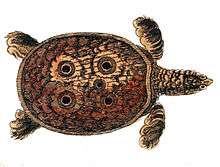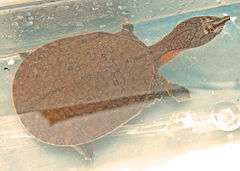Indian softshell turtle
| Indian softshell turtle | |
|---|---|
 | |
| Immature (the dark eyespots on the carapace are indistinct or absent in adults)[1] | |
| Scientific classification | |
| Kingdom: | Animalia |
| Phylum: | Chordata |
| Class: | Sauropsida |
| Order: | Testudines |
| Suborder: | Cryptodira |
| Family: | Trionychidae |
| Genus: | Nilssonia[2] |
| Species: | N. gangetica |
| Binomial name | |
| Nilssonia gangetica (Cuvier, 1825)[2][3] | |
| Synonyms[4] | |
| |
The Indian softshell turtle (Nilssonia gangetica), or Ganges softshell turtle is a species of softshell turtle found in South Asia in rivers such as the Ganges, Indus and Mahanadi. This vulnerable turtle reaches a carapace length of up to 94 cm (37 in).[1] It feeds mostly on fish, amphibians, carrion and other animal matter, but also takes aquatic plants.[1]
Description
The species is identified on the basis of the structure of the carapace and plastron. There eight pairs of costal plates, the last well developed and in contact throughout on the median line; two neurals between the first pair of costals; plates coarsely pitted and vermiculate. Epiplastra narrowly separated from each other in front of the ontoplastron, which forms an obtuse or a right angle; plastral callosities very large, hyo-hypoplastral, xiphiplastral, and, in old specimens, ento-plastral. Dorsal skin of young with longitudinal ridges of small tubercles. Head moderate; snout (on the skull) about as long as the diameter of the orbit; interorbital region, in the adult, considerably narrower than the nasal fossa; postorbital arch one third to one half the greatest diameter of the orbit; mandible with the inner edge strongly raised, forming a sharp ridge, which sends off a short perpendicular process at the symphysis; the diameter of the mandible at the symphysis does not exceed the diameter of the orbit. Olive above; back of young vermiculated with fine black lines, but without ocelli; head with a black longitudinal streak from between the eyes to the nape, intersected by two or three inverted-V shaped black streaks; lower parts yellowish. Length of dorsal disk 2 feet.[5]
In culture
These turtles are often maintained in the temple ponds of Orissa where they are considered sacred.[6]
Gallery
 Ventral side of Nilssonia gangetica
Ventral side of Nilssonia gangetica Skull structure of Nilssonia gangetica
Skull structure of Nilssonia gangetica
References
- 1 2 3 Ernst, C.H.; Altenburg, R.G.M.; and Barbour, R.W. (1997). Aspideretes gangeticus, Turtles of the World. Retrieved 17 June 2014.
- 1 2 3 Rhodin 2011, p. 000.207
- 1 2 Nilssonia gangetica from the Redlist
- ↑ Fritz Uwe; Peter Havaš (2007). "Checklist of Chelonians of the World". Vertebrate Zoology. 57 (2): 310. ISSN 1864-5755. Archived from the original (PDF) on 2010-12-17. Retrieved 29 May 2012.
- ↑ Boulenger, G. A. 1890. Fauna of British India. Reptilia and Batrachia.
- ↑ Annandale, Nelson; Shastri, Mahamahopadhyaya Haraprasad (1914). "Relics of the worship of mud-turtles (Trionychidae) in India and Burma". Journal of the Asiatic Society of Bengal: 131–138.
- Anderson,J. 1872 Note on Trionyx gangeticus, and Trionyx hurum, B. Hamilton. Ann. Mag. Nat. Hist. (4) 9: 382-383
- Anderson,J. 1872 On Trionyx gangeticus, Cuvier, Trionyx hurum, B.H. and Dr. Gray. Ann. Mag. Nat. Hist. (4) 10: 219-222
- Cuvier, G.L.C.F.D. 1825 Recherches sur les ossemens fossiles de quadrupèdes, où l'on rétablit les caractères du plusieurs espèces d'animaux que les révolutions du globe paroissent avoir détruites. Dufour & d'Ocagne, Paris. ed. 3, 5 vols. (Parts of this 5 volume edition are cited as appearing from 1821 to 1824; volume 5 appeared in 1825. It consists mostly of articles reprinted from Annales du Muséum d'Histoire Naturelle, Paris. See also Cuvier 1812.)
- Webb, R.G. 2004 Trionychid turtle miscellany. Hamadryad 28 (1&2): 119-121
- Bibliography
- Rhodin, Anders G.J.; van Dijk, Peter Paul; Inverson, John B.; Shaffer, H. Bradley; Roger, Bour (2011-12-31). "Turtles of the world, 2011 update: Annotated checklist of taxonomy, synonymy, distribution and conservation status". Chelonian Research Monographs. 5. Archived from the original (PDF) on 2012-01-22.

